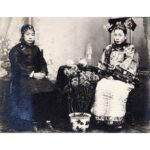Photography Deteriorated Armillary Sphere in the Ancient Beijing Observatory
A black-and-white photograph showing a bronze truncated armillary sphere (jianyi 簡儀) on display in the courtyard of Beijing’s Gu Guanxiangtai Observatory 北京古觀像台. Unlike the other instruments at the observatory, this sphere predates the last renovation of the observatory in the 17th century. It was also not built by the Jesuits, but designed and built in the 13th century by Guo Shoujing 郭守敬 (1231–1316), the builder of the observatory. This armillary sphere is the first known equatorial astronomical measuring instrument in the world. The instrument is extremely beautifully decorated; for example, the circles are supported by richly inlaid bronze columns, and dragons wind around some of the columns. The original blunt armillary sphere is now in the Zijin Mountain China Scientific Observatory 中国科学院紫金山天文台 in Nanjing. It was brought there in 1933 when the Japanese army approached Beijing. In today’s Old Observatory Museum in Beijing, ... more
A black-and-white photograph showing a bronze truncated armillary sphere (jianyi 簡儀) on display in the courtyard of Beijing’s Gu Guanxiangtai Observatory 北京古觀像台. Unlike the other instruments at the observatory, this sphere predates the last renovation of the observatory in the 17th century. It was also not built by the Jesuits, but designed and built in the 13th century by Guo Shoujing 郭守敬 (1231–1316), the builder of the observatory. This armillary sphere is the first known equatorial astronomical measuring instrument in the world. The instrument is extremely beautifully decorated; for example, the circles are supported by richly inlaid bronze columns, and dragons wind around some of the columns. The original blunt armillary sphere is now in the Zijin Mountain China Scientific Observatory 中国科学院紫金山天文台 in Nanjing. It was brought there in 1933 when the Japanese army approached Beijing. In today’s Old Observatory Museum in Beijing, visitors can see a replica of this instrument, which is only one-third the size of the original.
The Old Beijing Observatory is one of the few observatories from the period before the invention of the telescope that have survived to the present day. The site covers 10,000 square metres with a main brick platform measuring 40 by 40 metres and 15 metres high. Today, the observatory is a museum open to the public. It was built during the reign of Emperor Kangxi 康熙 (reigned 1661–1722) – on the foundations of a 12th-century precursor. Renovations were carried out under the supervision of Flemish Jesuit and missionary Father Ferdinand Verbiest (1623–1688). In 1900 the observatory was looted by the French invaders, but in 1902 the instruments were returned “to their place”. In 1956 the observatory became a museum.
The photograph is the 166th of 449 photographs of Beijing and its surroundings in the album of Ivan Skušek Jr., purchased during his stay in Beijing (1914–1920). In the handwritten inventory of the album, the photograph is referred to as Sternwarte: Kalender-Kreise. (DZ, MV)





































Do you have a comment or additional information about the subject?